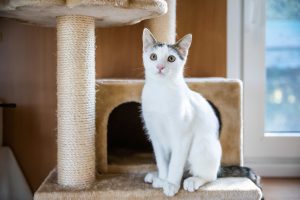Why do cats climb up and sharpen their claws on household furniture?
Cats have an essential need to climb and scratch, but they have an unfortunate tendency of doing this on the household furniture.
One of the resident cats in our shelter next to a scratching post
Expecting a cat to stay away from elevated surfaces is like asking a human not to walk. It is in a cat’s nature to climb and interact with their space across multiple levels. For a house cat, activities like climbing, jumping, and descending from high places – whether it be furniture, tables, chairs, shelves, bookcases, half-empty shelves, nightstands, or wardrobes – are entirely natural. Adopting a cat involves accepting and understanding this characteristic kind of behavior. While life is undeniably simpler for cats with access to a garden, it is important to ensure that all indoor cats have similar opportunities.
Your furniture can be adapted to your cat’s climbing and scratching needs
We have a responsibility to help our cats explore elevated spaces by installing tall scratching posts in the home from which they can observe their surroundings without being disturbed, or by placing a blanket on top of a a closet that they can reach with the help of a stool or shelf, or by creating pathways along walls using shelves. There are numerous solutions available these days, many of which complement home decor beautifully.
Above all, it is crucial not to underestimate the significance of allowing cats to “scratch” surfaces. Living with a cat doesn’t have to result in finding ourselves with a badly scratched sofa; understanding and addressing their need to scratch is paramount. Discouraging or prohibiting scratching by shouting or meting out punishment will only harm our relationship with our pets. But we do need to understand his or her motives and learn how to direct them in the right way, so that our furniture is not damaged.
Thinking about getting a scratching post? It’s actually better to have two — one vertical and one horizontal
Scratching rough surfaces helps cats keep their claws sharp, stretch their muscles, and maintain healthy joints and tendons. But it’s not just about their physical health; scratching also plays a crucial role in cat communication, especially in cases where there are multiple cats in the same territory or household. When cats scratch, they not only leave visible marks but the glands present between their paw pads release interdigital pheromones onto the scratched surface, leaving behind an unmistakable olfactory scent for the other cats in the home.
This behavior is linked not only to physical but also cognitive and emotional needs and is essential for your pet’s well-being. If your cat is not free to go outside, scratching posts become essential for them to fulfill these natural activites. That is why they should always be available in the home, regardless of the need to protect the furniture.
Why do cats sharpen their claws on the sofa?
The sofa is a is a communal spot where different members of the family (humans, dogs and cats) spend time together. For cats, the sofa therefore becomes a prime location to leave visual and olfactory markings. In addition, sofas often have a coarse-textured fabric that cats find irresistible. Our top tip: when you are choosing fabric for armchairs, beds, chairs, or sofas, opt for smooth textures; this might help deter scratching, although it definitely shouldn’t replace the need to have scratching posts in the home!
Consider these pointers when selecting scratching posts:
- Opt for posts that have a sturdy base to withstand your cat’s weight without tipping over.
- Choose tall posts that allow your cat to stretch out fully.
- Some cats prefer horizontal scratching; in this case, cardboard boxes with scratching surfaces at the bottom or jute mats/shelves are a good alternative.
- Remember that it is always preferable to offer both horizontal and vertical scratching options.
Where to place scratching posts
Where you place the scratching posts is also important. You often hear people say that cats don’t use the scratching posts. If this is the case, this is usually because they are not tall enough or because they have not been put in the right place.
Cats love to scratch and stretch right after waking up, so placing a post near their resting spot is an ideal choice for this activity. Observe your cat’s habits and place a scratching post close to its favorite sleeping areas.
If you have more than one cat, consider placing scratching posts in parts of the home they pass through frequently or near doors and windows, where they are most likely to want to mark their territory.
Alternatively, if you know your pet already has favorite spots where they like to scratch, try positioning scratching posts nearby, ensuring that they are easily accessible and introduce them properly to your cat. Catnip powder can also be a useful tool for marking the places where you are happy for your cat to scratch. Simply rubbing catnip onto a scratching post will encourage him or her to use it.
Another trick is to guide your cat to the scratching post using a feather wand, dragging it up the post so the cat follows suit and climbs up onto it.
How do your cats like to scratch? Do share your videos with us ! 😊
